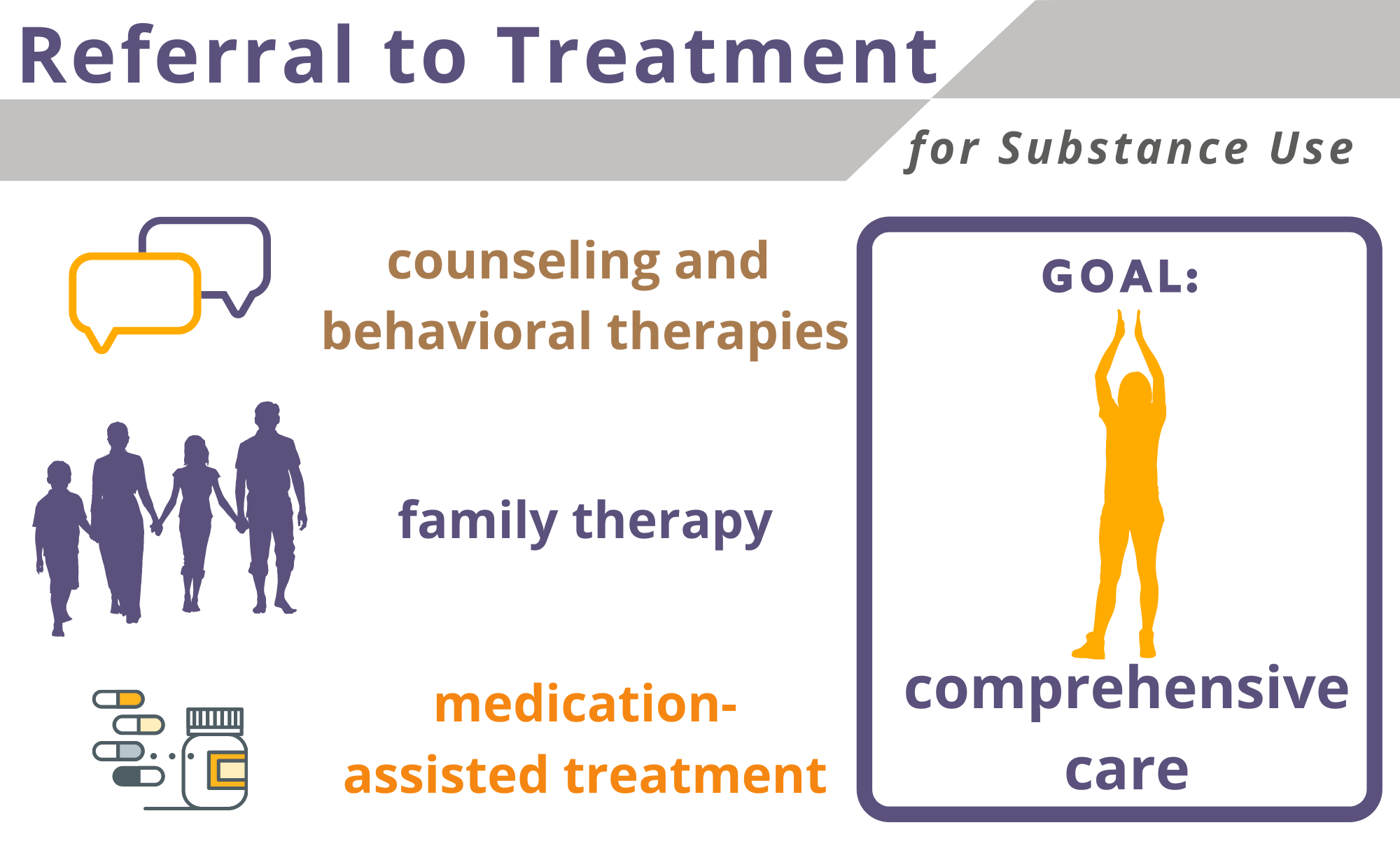
Why Adopt Referral to Treatment for Substance Use?
- Nationwide, 30% of high school students report having used alcohol in the previous month.1
- Fourteen percent of high school students report illicit drug use.2
- Between 1991 and 2012, the rate of non-medical use of opioids by youth, and the rate of OUD, more than doubled.3
Referral to treatment is intended for youth who have a substance use disorder (SUD) and therefore need specialty SUD treatment that is typically beyond the scope of primary care settings such as SBHCs.
What are the different types of SUD treatment?
There are many different types of treatment for youth with SUDs. The treatment types can fall into these general categories:
Behavioral approaches
Psychosocial approaches address the underlying causes and impacts of SUD, ranging from individual counseling to group therapy. One common approach to OUD and other SUDs is Cognitive-Behavioral Therapy (CBT). Short-term behavioral treatment is sometimes provided by trained and qualified behavioral health providers at SBHCs.
Family-based approaches
When possible, including a young person’s family in treatment is highly recommended. One evidence-based approach is Brief Strategic Family Therapy. Family treatment can also sometimes be provided by a behavioral health provider at the SBHC.
Medication-assisted treatment (MAT)
These are medications that are effective in helping treat people with SUDs. There are medications for OUD as well as alcohol and nicotine use disorders. MAT uses FDA-approved medications that treat withdrawal symptoms and physiologic cravings. Stabilizing patients with OUD medically first often helps them recover and engage in ongoing treatment. Research has shown medications used in MAT do not adversely impact physical or mental functioning.4
What are best practices when implementing referral to treatment?
What should I do now?
- Learn about the treatment community in your area, especially centers that serve youth and offer MAT.
- Get to know providers currently providing MAT in your area, especially those that have training or experience with youth.
- Share this fact sheet and your perspective about MAT with youth-serving colleagues. Help raise awareness and reduce stigma about MAT in the adolescent primary care community.
- Encourage parents and families to safely store opioid prescriptions and safely dispose of prescriptions that are expired/no longer needed.
- Ensure you are reviewing the updated educational requirements so you can continue to prescribe buprenorphine.
- Encourage your medical and dental colleagues to avoid prescribing opioids for acute pain and to explore alternatives for treating chronic pain.




 Medical professionals recommend MAT for adolescents 16 and older. The American Academy of Pediatrics and other trusted professionals recommend that adolescents with OUD be offered pharmacotherapy with buprenorphine, naltrexone, or methadone. No age-specific safety concerns have been identified, and MAT is consistent with a harm reduction approach that most adolescent providers embrace in other aspects of care. SBHC providers should know about therapies such as buprenorphine and be able to make a productive referral to someone who offers MAT when indicated. Some adolescent providers should even consider prescribing MAT to their youth patients when indicated.
Medical professionals recommend MAT for adolescents 16 and older. The American Academy of Pediatrics and other trusted professionals recommend that adolescents with OUD be offered pharmacotherapy with buprenorphine, naltrexone, or methadone. No age-specific safety concerns have been identified, and MAT is consistent with a harm reduction approach that most adolescent providers embrace in other aspects of care. SBHC providers should know about therapies such as buprenorphine and be able to make a productive referral to someone who offers MAT when indicated. Some adolescent providers should even consider prescribing MAT to their youth patients when indicated.



